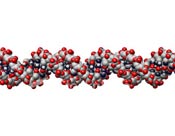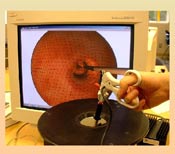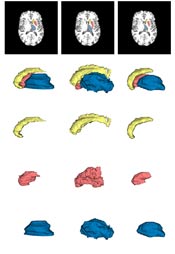Research > Labs - Groups & Institutes
Collaborative Research and Industrial Relations
Graphics, Usability, and Visualization Lab
Logic & Functional Programming Group
Medical Image Computing and Analysis (MICA)
Multimedia and Wireless Networking Group
Network Modeling Research Group
Systems Networking and Architecture Research Lab
Affiliated Research Institutes
Mathematics of Information Technology and Complex Systems (MITACS)


Algorithms & Complexity Group
The Algorithms and Complexity Group is interested in the theoretical aspects of Computing Science and in the application of this theory to modern industrial uses. The group has broad interests including computational geometry, parallel algorithms, distributed algorithms, operations research, and graph algorithms. We have a particular interest in the development of algorithms for optimization problems. Some of our current projects have application in the areas of biomedical image processing, geographical information systems, communication networks, scheduling, robot motion planning, pattern recognition, and VLSI layout. In addition to our own research, we consult for industry and advise other academic researchers.


Autonomy Lab
The Autonomy Lab builds life-like machines. Our goal is to increase the autonomy (i.e. self-direction and self-maintenance) of robots and other machines.
There are two main reasons to study autonomous machines:
Scientific: an autonomous machine is a concrete test of hypotheses about mechanisms of intelligent behaviour. We come at this from two directions: a bottom-up approach examining the necessary and sufficient conditions for rational behavior; and a top-down approach realizing and testing models of human and animal intelligence.
Economic: by definition, autonomous machines can do more work than those which require human supervision. Autonomous robots could make society more efficient by enabling new kinds of industry, science and exploration.
The acquisition and management of resources such as energy and space is a fundamental, unavoidable task for all living things. From an ecological perspective, intelligent behaviour can be seen as rational manipulation of resources. This observation underlies our approach to building autonomous systems.
- Highly autonomous, long-lived robots
- Biologically-inspired robots
- Adaptive networks and sensor networks
- Minimalist, micro and very low-power robots
- Enabling technology to increase human autonomy
- Artificial life
- Robot simulation, programming and research tools
Our research projects include:
Chatterbox, Misbehaviour, Mother, Player, Rage and Zoo.


Computational Biology and Bioinformatics @ SFU
What is Bioinformatics? The definition of bioinformatics is currently controversial, but bioinformatics can be loosely defined as the use of computers and computer science to study biological questions. It forms the intersection between molecular biology (and related biological disciplines) and computer science.
This interdisciplinary field involves researchers who work at many different points on the computer science-biology spectrum: From those who are developing new relevant algorithms, to those who are developing and using computational applications to study biological phenomena, gain new insight into the life sciences, identify new drug targets etc. This field is currently evolving, but one point is agreed upon: Bioinformatics is a blossoming field within which there remain many significant discoveries to be made.
Our research interests are generally in some of the following areas:
- Comparative Genomics
- Complexity Theory and Optimization
- Databases and Data Mining
- Eukaryotic and human genetics and genomics
- Membrane and DNA Biophysics
- Enabling technology to increase human autonomy
- 3D visualization
- Phylogenetics and Evolutionary Genomics
- Statistical Genetics and Epidemiology
- Structural Proteomics
Some current Genome Canada Projects at SFU are:
- C. elegans: Expression Profiles of Cells and Tissues
- Functional Pathogenomics of Mucosal Immunity
- Genomics Research on Atlantic Salmon
Computational Logic Lab
The SFU Computational Logic Lab is a group of researchers interested in the study of logics which are useful for expressing or solving computational problems, and the computational properties of those logics.
There are many connections between logic and computation. Historically, the best-known is in the study of computability, which also led to the discovery of deep connections between logic and complexity theory. Other areas where logic has played an important role in progress on problems of computational interest include programming languages, database theory, artificial intelligence, system specification and verification.
Interests of the members of the group include, among other areas, logics for knowledge representation and for representing and reasoning about dynamic systems, belief revision, theorem proving, constraint satisfaction, database theory, and complexity of related computational tasks.
Current research work includes:
- Knowledge Representation and Reasoning in Artificial Intelligence
- Combinatorics, Optimization and Complexity Theory
- Propositional satisfiability and finite domain constraint satisfaction
- Machine Learning
- Logic and Computation



Computational Vision Lab
Computational Vision deals with enabling computers to use visual information. Our primary focus in the Vision Lab at SFU is in understanding colour: How are colours perceived? How can colours be reproduced accurately on different media? In what ways does colour help in understanding images?
You may have experienced untrue colour while using home video cameras or been frustrated because your colour printer does not give you the same nice colours you previewed on your LCD screen. Often poor colour rendition results more from our limited understanding of colour perception than it does from limitations of our colour producing devices.
For us to build machines that reproduce colours accurately or to make effective use of colour in robotics, we need to understand human colour perception. The last decade has produced many interesting new computational theories of colour coming from both computer science and psychology.
Members of the Computational Vision Lab conduct research into machine vision and image processing, with emphasis on computational models of colour vision.
Research Areas:
- Colour Constancy Algorithms
- Object Recognition Using Colour Indexing
- Sensor Sharpening
- Image Enhancement and Dynamic Range Compression
Our lab has affiliations and funding support from: Natural Science and Engineering Research Council, Samsung Incorporated, B.C. Advanced System Institute and Creo Inc.


Database and Data Mining Lab
TURNING DATA INTO KNOWLEDGE
In todayís information society, we witness an explosive growth of the amount of data becoming available in electronic form and stored in large databases. Data mining is the process of turning data into useful knowledge by finding previously unknown patterns in large databases.
Our lab was one of the earliest contributors to the field of data mining and we enjoy innovative new algorithms that advance the field even further. FPGrowth, DBScan, PrefixSpan are some of the many well-known and widely used algorithms innovated by our Lab. Our algorithms are currently used by leading retailers, banks, finance firms, online shopping portals, search engines, database software vendors and private and governmental research institutions.
Some of our current research projects are:
- Privacy preserving data mining
- Genomics data mining for personalized medicine
- Geo-spatial data mining for crime prevention
- Mining graph and multi-relational data for community identification in social networks
We have strong ties with the industry, research institutions and the government such as NSERC, Michael Smith Foundation for Health Research, IBM and Hewlett-Packard. Our funding consists of 11 grants from Canadian government and industry.
We are honored to have been awarded 3 best papers, 1 runner up paper and 1 B.C. Innovation Council Young Investigator award.



GRaphics, Usability, and VIsualization (GRUVI) Lab
We are an inter-disciplinary team of researchers exploring and developing novel methods in Computer Graphics, Visualization and Human-Computer Interaction and using these methods in a variety of applications. Current areas of focus include Visualization, Geometric Modeling and Processing, Medical Imaging, Usability, and Haptic Interfaces.
The lab was first founded in 1992 by Professor Tom Calvert whose work in human animation led to the now famous LifeForms software and the startup firm Credo Inc. Today, we have a modern infrastructure, supported through two Canadian Foundation for Innovation (CFI) grants and a recent NSERC Research Tools and Instruments grant. Several NSERC Strategic Project Grants, along with other grants provided by NSERC, MITACS, and Precarn, secure the funding of our students. We collaborate with industry (in particular a number of local gaming companies) and researchers from across the globe. One of the industrial internships carried out by members of the lab had won an Award of Excellence from MITACS, the funding agency. While you will find many of our alumni all across the private sector in the lower mainland, some of our best graduates are now professors at the University of Victoria and the University of Florida.
- Visually Enhanced Exploration of High-Dimensional Data
- Spectral Methods for Mesh Processing and Analysis
- Experimental Design Space Explorer
- Fast Medical Reconstruction Techniques for Optimal Sampling Lattices
- Haptic Interaction Techniques
- Supporting Fluent Interaction
- Structural shape segmentation and correspondence
- Surface reconstruction and curve skeleton construction over incomplete point data


Logic & Functional Programming Group
Logic programming is the art of using logic to describe knowledge in a more human-oriented way than is possible with traditional programming languages. This is achieved by describing a problem domain in terms of facts and rules written in a simple subset of first-order logic. A hidden theorem-prover can then solve a particular problem in that domain by deducing, as needed, further facts from the facts and rules stored. Thus we can program declaratively, largely in terms of what needs to be done, rather than of how to do it.
The group's objectives are:
- To further the state of the art on the theoretical and practical aspects of developing declarative programming tools (in particular; logic programming, functional programming, constraint logic programming and logic grammars)
- To investigate the uses of these tools for concrete Fifth Generation Computing applications, and to facilitate result transfers and collaborations with other academic units and with industry.
The Logic and Functional Programming Group was formally established in 1990 as an independent research group. It is a strong interdisciplinary group comprising members from numerous SFU units, two UBC units, and from the University of Victoria and Aizu University in Japan



Medical Image Computing and Analysis (MICA)
Is composed of the Medical Computing Lab (MCL) and the Medical Image Analysis Lab (MIAL)
Anatomical and functional medical imaging modalities allow clinicians and scientists to peer inside the human body and provide a wealth of information. This information is indispensable for understanding, modeling, diagnosis and treatment of diseases. The number of medical images acquired on a daily basis has grown, finer details are captured with larger image sizes, and the dimensionality of images has increased from two dimensional scalar images to dynamic 3D multi-valued fields. This results in image data that cannot be effectively and accurately processed with traditional visual inspection techniques. The development of computational tools for medical image analysis therefore has tremendous value and is the focus of research at MICA.
Our research goals are motivated by different clinical applications related to neurological, musculoskeletal, cardiac diseases and oncological studies, including multiple sclerosis, Parkinsonís, shoulder maladies, tumor localization etc. The overarching theme of our research is the design of computational algorithms for extracting clinically relevant information from medical images with varying dimensionality and complexity.
We work with and are funded by local, national, and international clinical collaborators, who provide motivation, image data, and feedback. For e.g., TRIUMF, BC Cancer Agency, Lionís Gate Hospital, University of British Columbia, Hospital for Joint Diseases/New York University Medical Center, Vancouver General Hospital, Pacific Parkinsonís Research Centre.
Multimedia and Wireless Networking Group


Natural Language Lab
Natural Language Processing (NLP) is the automatic analysis of human languages such as English, Korean, etc. by computer algorithms. Unlike programming languages where the structure and meaning of programs is easy to encode, human languages provide an interesting challenge, both in terms of its analysis and the learning of language from observations.
Imagine that you talk in English on the phone and at the other end of the line your words are spoken in Chinese. Imagine a computer animated representation of yourself speaking fluently what you have written in an email. These are only some of the uses of NLP.
Our lab is active in areas of Information extraction, Machine translation, Summarization, and Statistical parsing. We have worked with: Arabic, Chinese, Czech, English, French, Hindi, Korean and Spanish.
The Natural Language Lab at SFU is one of the largest North American labs working on natural language processing and computational linguistics. We have a strong relationship with the natural language industry in Canada, the National Research Council, and various research groups around the world and within SFU. In 1999, lab researchers formed a company, Axonwave Software Inc., which uses language technology software.
Interested in machines that can learn language, understand language, and translate language? We are always looking for talented graduate students. We also actively explore connections to industrial/commercial applications of our research through collaborative grants and/or internships.
Network Modeling Research Group


Network Systems Lab
We are interested in the broad area of computer networking and distributed systems. We develop algorithms and protocols to enhance the performance of networks, especially the Internet, and to efficiently distribute multimedia content (e.g., video and audio objects) to large-scale user communities.
Our current research interests include:
- Peer-to-Peer Systems- Exploring the applicability of the P2P paradigm to build cost-effective content distribution systems.
- Multimedia Networking - Focusing on distributed streaming in dynamic environments and for heterogeneous clients.
- Wireless Sensor Networks - Developing coverage and connectivity maintenance protocols that consider more realistic sensing and communication models.
- Network Security - exploring network monitoring techniques to detect and thwart intrusion and denial-of-service attacks in their early stages by observing unusual traffic patterns injected by such attacks.
Our Lab houses the following equipment: nsl: Lab web and file server, nsl-cpu: 8-core server to run simulations and large-scale experiments, nsl-win: Windows Terminal Server for remote access, nsl-cl: 11 machines interconnected through a fast Ethernet switch, PlanetLab WAN Testbed: Access to several hundred machines distributed all over the Internet, Wireless Sensor Testbed: For implementing and testing protocols in the wireless sensor networks research area.


Software Technology Lab
Bridging the Gap between Computing Science and Software Engineering
R&D activities in SFUís Software Technology Lab focus on mathematical foundations of Software Engineering and innovative technology for high level systems design. Mathematical techniques and supporting tools improve the quality of software designs by establishing key system attributes in early design stages. Practical applications in various projects focus on system architectures in e-commerce, industrial automation, wireless communication, and telecommunication.
Our current projects are:
The Safeguard Project: It provides a novel computational approach to checking consistency, coherence and completeness of aviation security measures. It provides a platform for systematic analysis of the efficiency and effectiveness of such requirements.
The Mastermind Project: This is an interdisciplinary research project in Computational Criminology that provides criminologists with innovative computational models and supporting tools for studying crime and leads to novel strategies for urban planning, policy making and crime prevention.
The CoreASM Project: This is an interdisciplinary research project in Computational Criminology that provides criminologists with innovative computational models and supporting tools for studying crime and leads to novel strategies for urban planning, policy making and crime prevention.
Web Services Architecture: It focuses on developing an executable formalization of BPEL4WS as a semantic basis for checking correctness and completeness of the informal language definition using experimental validation in combination with inspection by analytical means.



Vision & Media Lab
The Vision and Media Lab conducts research in Computer Vision and Multimedia. Some of the high level problems being examined in this lab are:
Human Activity Recognition The goal of human activity recognition is to build systems that can find human figures in either still images or video sequences, and determine what action they are performing. Such systems are being used for surveillance and security.
Lighting Invariance Unlike humans, computer programs aimed at image understanding view lighting changes as distractions. We look at removing these distractions using image processing to produce images that are invariant to lighting change. This has resulted in the development of images that are unchanged from the original, except that the shadows are removed.
Active Video Active videos are object-centered, and often exhibit prominent shifting and holding behaviours of the human operator. This research focuses on the automatic extraction of video objects from active video and their 3-D reconstruction, which will facilitate video indexing and retrieval.
Content-Based Image Retrieval Users can retrieve image and video contents from the Internet based on key words as well as common features such as colour, texture, shape and other conjuncts. This research focuses on issues of Search by Illumination Invariance and Search by Object Model.



Systems Networking and Architecture Research Lab
BUILDING REAL SYSTEMS THAT SOLVE REAL PROBLEMS
Our group focuses on applied research in systems, networking and computer architecture. We build real systems that solve real problems, such as design of an operating system for future many-core processors and implementation of cost-effective large-scale video broadcast over P2P networks. We begin with a solid theoretical base, and then implement and evaluate our solutions in real operating systems and real networks. Our philosophy is to create the synergy between systems and theory that would produce robust technology for the real world.
Our commitment to real technology is underscored by our industrial partnerships. Industrial leaders such as Sun Microsystems and Hewlett Packard support our research. In addition, our group holds thirteen grants from industry and the Canadian government and has published over 80 publications in top venues, including book chapters and ten patents.
Our lab is equipped with high-end multiprocessor systems from Sun, including its latest UltraSPARCģ T1 server with multithreading on the chip, and the 32-CPU shared-memory multiprocessor E6500, a wireless sensor network testbed of 16 Mica2 motes, and a media streaming testbed of multiple servers and proxies, which is also connected to the global PlanetLab network.